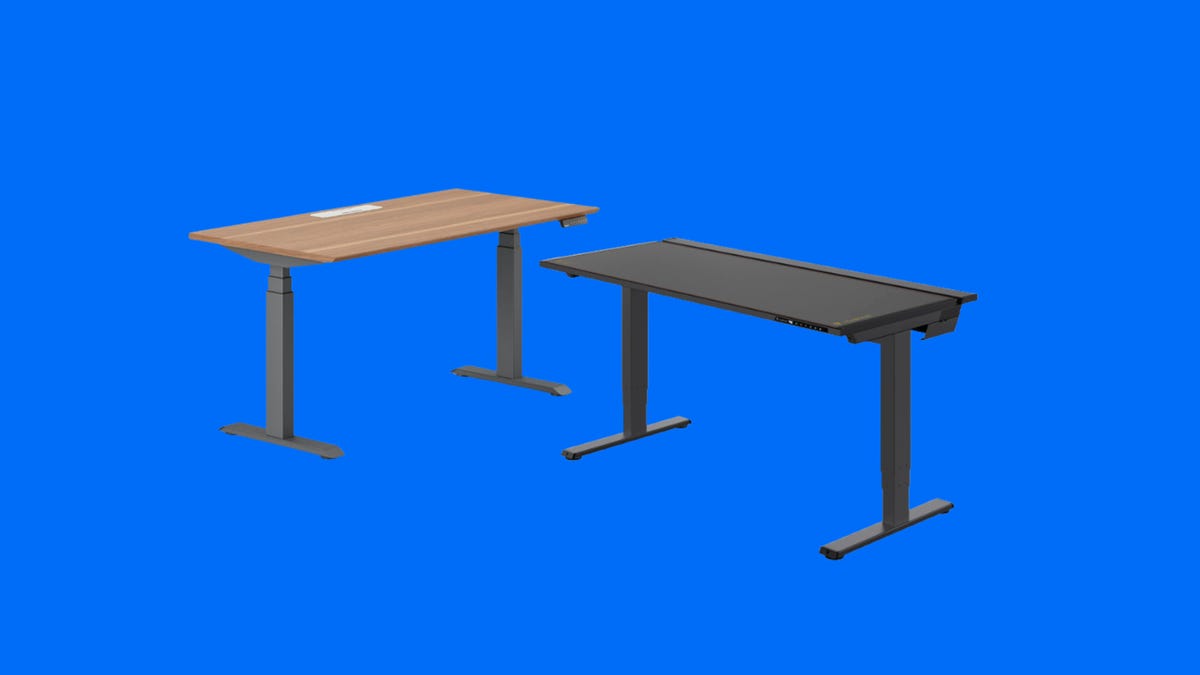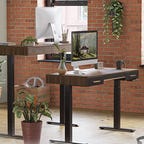Best Desks 2023: Standing Desks, Gaming Desks and Everything in Between

Fenlo writing desk
A budget-friendly writing desk with added extras

Fezibo midcentury modern electric standing desk
A writing desk meets standing desk
Having a desk at home is a necessity, not just for working professionals but also for students, crafters, gamers and just about everyone else. Every home should have at least one desk. You may work from home, or need a place to do homework. Maybe you’re a gamer and want to get into Twitch streaming. All of the above ambitions require a comfortable work surface to succeed.
CNET has had a “best standing desks” article for a while now, and we know what the best office chairs and gaming chairs are, so now is the time to give you options beyond standing desks. This article has everything you need, from standing desks to small writing desks and beyond.
I’ve spent hours building desks, moving desks and sitting at and on desks, all to give you the lowdown on the greatest around. I keep getting more too, so watch this space for more of the best desks as they arrive.
I have used a lot of desks over the course of my career, but I can honestly say I’ve never used a desk quite like the Magnus Pro XL. It is at once the most industrial-looking table, while also giving off huge gamer energy. Measuring 70 inches long and made almost exclusively of metal parts, this desk is not meant for one-person assembly. It took nearly two hours to put it all together, but once it is finished, it’s a work of art.
It has a five-setting standing system, and the motors are some of the quietest I’ve heard in my testing. The motion is smooth, and even though the desk weighs quite a lot, it rises quickly and without hassle. I never thought of using a standing desk for gaming before, but it really helps to break up the hours of sitting.
At first glance, the Branch standing desk looks pretty generic, but the level of craftsmanship is apparent on closer inspection. All of the materials feel premium, with a weight that only comes from good engineering.
This light writing desk is a lot like many of the others I tested. Writing desks tend to be easy to put together — this one took 10 minutes — and are small in stature. It can hold maybe one monitor and a laptop comfortably, but not much else.
Most standing desks have a clinical look to them like they are designed to be in a drab office rather than your home. Not so with the mid-century standing desk. Its design with dark wood surface, black drawer fronts and antique gold handles gives an air of ’50s sophistication.
The standing desk portion works well too with four programmable heights and a sturdy structure that feels secure even at full extension. I especially like the center drawer that can fit your wireless keyboard and mouse to hide them from view and keep the midcentury aesthetic.
Other desks we tested
Not every desk we test makes it onto the best list. Some of them aren’t even good enough to get a mention. Some though are close to being good enough and we are willing to mention them here. These desks had something wrong that kept them off the top spot, but are decent if you can overlook the specific issue.
This desk from Homary looks fantastic when it is all put together. The glossy white finish and antique gold accents give it the luxurious feel a $1,500 desk should have. All of the individual parts have the weight that you expect from an executive item, and once it was all put together it looks absolutely stunning.
Gaming desks can often be extremely expensive, especially when you add extras. This desk from Monoprice is simple, cheap, and stable — all good things — and also has some neat extras like a headphone hook, cable management tray, and an off-desktop cup holder. Having your beverage off to the side of the desk is a great idea. If you knock it over, it’s going on the floor, not on the expensive electronics on your desk.
How we test
Testing desks is something of a subjective game. Much like office chairs, the tests are based on comfort, reliability and ease of setup rather than things you can test in electronics such as wattage and battery usage. I still tested each one rigorously however, and will continue to test them for longevity in the coming months.
I tested these desks by asking three people to try each one. Each of them used the desk for at least 16 hours and then gave me their impressions. The three people were 6-foot, 1 inch; 5-foot 8 inches; and 5-foot, 4 inches tall, respectively to give me a good cross-section of average user height.
Setup time and package quality
Building desks can often be difficult and time-consuming. For each desk, I timed how long it took to unpack and assemble, and I noted if the manual was easy to follow or not. I followed the instructions as closely as possible so that each build was performed as if I had never built one before. I also thoroughly checked the packaging, to make sure it wasn’t damaged, and if it was secure enough to carry the desk it had in it. Any damage was noted, and images were sent to the manufacturers for review.
Structural integrity
Modern desks need to be able to hold a good amount of weight. If you’re at a writing desk you might only have a small laptop, but if you’re using a gaming desk, it likely has two monitors and a giant gaming PC as well. For each desk, I checked the maximum load specification, and I tried to match that with the materials we actually use on our desks.
I used:
- A heavy gaming PC tower
- Two 27-inch gaming monitors on a dual monitor arm
- A MacBook Pro
- Two different keyboards and assorted mice and trackpads
- My Oculus Quest 2
- My phone stand and USB hub
- A podcasting mic and headphones
Depending on the length and weight capacity of the desk, I mix and match these items, then check for any bowing of the top or inconsistencies in how the desk felt as I worked.
The wibble-wobbles
This is a bit of a throwback from when my dad used to make furniture. Anything my dad built would be critiqued by my mum, and if it didn’t pass muster she would say “It’s a bit wibbly-wobbly, isn’t it, Dear?” Once I have built each desk and loaded it for normal use, I would check it for the wibble-wobbles. This means rocking it from side to side and forward and backward to check that all the screws, bolts and fixtures kept everything rigid.
Source: CNET














